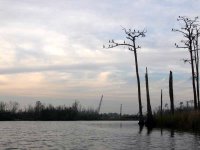

(1) Above left. Today was another one of those dark, cloudy, dreary winter days, but not very cold. This pelican was eyeballing the human in the boat with no motor. (2) Above right. While passing the Chickasaw marine industrial area, a barge with no shame kept on leaking.


(3) Above left. Up in a little slough, it looked like the algae were having a bad hair day. (4) Above right. This mushroom, spreading out its wings, looked like a good texture photo. If you want to see some awesome photos of mushrooms, check out Taylor Lockwood’s mushroom photos.


(5) Above left. In the Pumphouse Canal, one tree looked unusual. Upon closer inspection, what appeared as buds from a distance, were actually leaf galls. To learn more about leaf galls, check out Wayne’s Word. (6) Above right. Kayaking in the Pumphouse Canal always puts me on edge. If it isn’t the insects, it is the critters, however, this one was not moving.


(7) Above left. While in the Pumphouse Canal, the mosquitoes were having a field day with my blood. Next time I’ll bring some repellent! Here, upon exiting the Canal, the sky started changing colors. I thought this was the sunset. Wrong! Sadly, while driving home after loading up the kayak, the real sunset started to display some beautiful colors that lasted for 20 minutes. Sure wish I’d been on the water during that display. (8) Above right. This is where the LST-325 used to be. If you want to see the LST-325 now, you’ll have to go to Evansville, Indiana.


(9) Above left. Up in Black Bayou, some of the bare trees were loaded down with Cormorants or Anhingas. (10) Above right. This woodpecker was noisily looking for food while there were a few moments of light left in the day.
Note: The last time I went down Chickasaw Creek, there was green water bubbling up that smelled like raw sewage. I thought a sewage pipe might have been broken. To update, there is a sewage disposal site just south of the creek. There was green flow from the pipe today, just like in the past and apparently that is normal. However, today, there was no smell of sewage in the air. Ahhh.



























